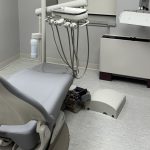Nearly five years ago, Teri Cook felt some twitching in the bottom of her right eyelid that wouldn’t go away. What this 44-year-old from Perth, Australia, thought might be the side-effects of a strenuous weightlifting workout soon turned into a health nightmare. It would essentially rob her of many of the pleasures in her life—attending parties, reading, even going outside to bring in the mail—before sending her thousands of miles away to Pittsburgh for help at UPMC.
After visits to an ophthalmologist and multiple neurologists in Australia, she was ultimately diagnosed with hemifacial spasm, or HFS, a neuromuscular disorder characterized by frequent, involuntary contractions on one side of the face. Most often, it’s caused by a blood vessel pressing on the facial nerve at the point where the nerve exits the brainstem.
Cook, who manages the family investment company from home, quickly tried the most common treatment for the disorder—injections of botulinum toxin. By that time, she couldn’t read, work on her computer or safely drive because of the effects of the spasms. She’d become a virtual recluse in her own home, avoiding her husband’s work functions and afraid to show her contorted face to friends and neighbors. The regular shots of botulinum toxin were becoming increasingly less effective and gave her face a frozen, stroke-like appearance, she recalls.
Desperate and miserable, she soon learned of a surgical procedure, called microvascular decompression, that could relieve the pressure on the facial nerve that was causing the problem. Warned by some doctors that the surgery could be “highly risky,” she says, she plunged ahead anyway and had the procedure in Australia in 2011. It worked—but, sadly, only for three days. “I was just devastated,” says Cook. “And it just got worse and worse.”
Determined to find a cure, she continued her online search for a permanent solution and finally found it on a Facebook page for HFS sufferers, which led her to Raymond F. Sekula, Jr., M.D., director of UPMC’s Cranial Nerve Disorders Program. One of the most experienced surgeons in the world when it comes to treating HFS, Dr. Sekula has performed more than 500 microvascular decompressions. New techniques and tools, he says, are producing better results for patients. Side effects like stroke and hearing loss are increasingly rare, and more than 90 percent of his patients have become spasm free.
After making contact with Dr. Sekula and the UPMC Global Careprogram, which helps to coordinate care, housing and other services for international patients, Cook learned that Dr. Sekula could help. Despite her earlier surgery, MRI images showed that there was still significant compression of her facial nerve by a blood vessel, says Dr. Sekula. So she and her husband, Warren, left their 21-year-old daughter behind and made the 35 hour trip from Perth to Pittsburgh—her first trip to the U.S. She had microvascular decompression surgery at UPMC on March 26 and was in the hospital for less than 24 hours.
Since then, she’s seen remarkable improvement—although it could take nearly two years before she is spasm free, according to Dr. Sekula.
“It is the most wonderful feeling when my face is quiet and the drumming in my ear stops!” she recently wrote to him from Australia. “Today whilst Warren and I were shopping, I was able to feel confident in looking shop-keepers in the face and chatting to them with two open, engaged eyes! What a delicious experience!!!”








